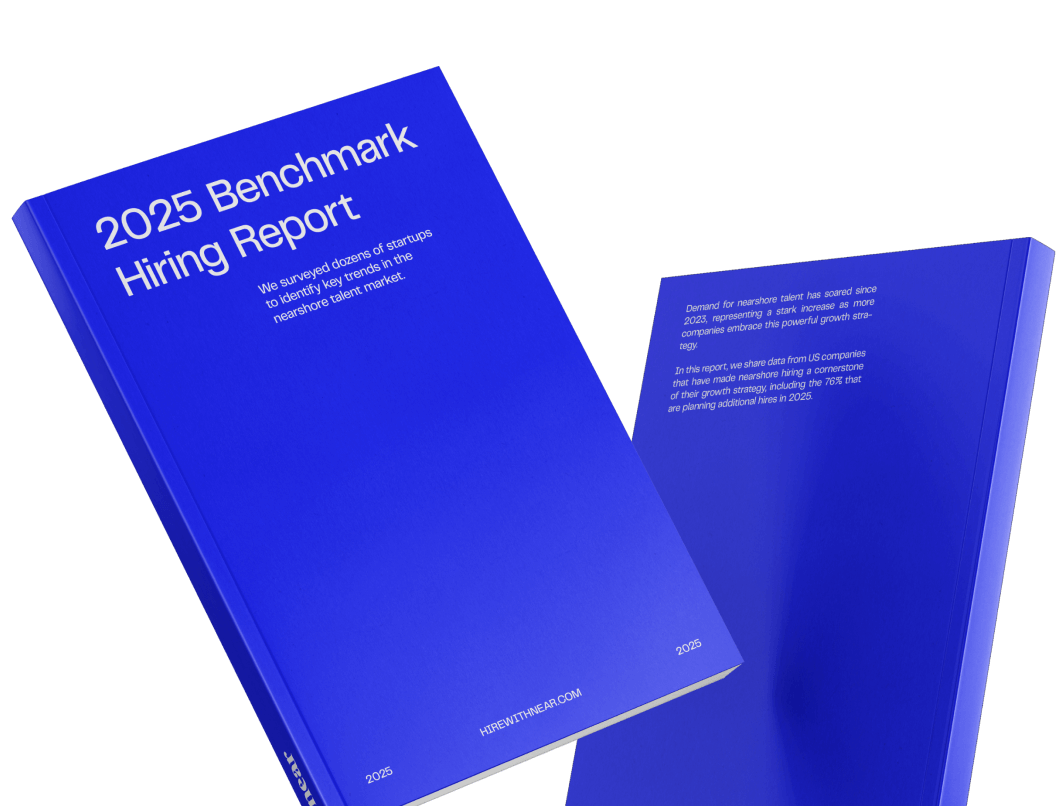It can be tempting for employers to revert to the “show me the money” strategy of enticing new talent to their organizations. Times are changing rapidly, though, and simply showering new prospects with hefty salaries is now only half the equation.
It’s never been more challenging to attract and retain employees. In most workplaces, a 90% retention rate and a 10% departure rate are generally considered good. The stats paint a different story: the 2021 Bureau of Labor Statistics report revealed an average yearly turnover rate nearing 57%.
This means, depending on your sector, you might lose more than half your workforce each year. Half. That is unless you take a hard look at your approach to recruiting, hiring strategies, and company culture and make the necessary changes to ensure this doesn’t occur.
In this article, we’ll guide you through the steps necessary for making an effective job offer and putting together a package that will attract the best candidates near or far and retain them for years to come. Read on to learn how to create a winning job offer strategy for your organization.
Why Is Making a Good Offer Important?
Making a good job offer goes beyond simply offering wages and benefits packages that meet industry standards; it’s about understanding the value of an employee to your business. A well-crafted offer can be key to acquiring and retaining top talent, allowing you to build a thriving team that will help you succeed.
Not only does making a good job offer attract potential employees, but it also helps cultivate loyalty among current staff members who have reaped the benefits of similar offers during their hiring process.
When current employees see a culture of care and employee engagement being modeled by their bosses through fair and equitable hiring practices, they see consistent proof and enforcement of company values.
Employees who feel valued are more likely to stay with your company longer and provide better results over time than those who don’t feel appreciated or supported.
Moreover, a good job offer sends the right message about your company’s commitment to its employees. It conveys that you are serious about finding and keeping great people who will add value to your business. This is especially important in competitive industries where top talent is hard to come by; making an attractive offer may be the deciding factor when it comes to getting the best of the best.
What Are the Steps to Making a Good Offer?
To ensure you are successfully hiring the right people for your company, there are several guiding principles you can follow leading up to getting that “yes” to your offer.

Make sure you have the most suitable candidates
It all starts with your recruiting process. It is vital to ensure that you are making an offer to the most suitable candidate for the job. Here are a few best practices in key talent acquisition to help you with this.
- Be patient. Take time to ensure you hire the right candidate by reviewing resumes, considering references, and allowing sufficient time to ensure you are bringing superior talent through to the interview stage.
- Check for required skills. It is important to ensure that your short-listed candidates have all the qualifications, certifications, and experience needed for the role.
- Use available technology. Having the right tools and strategies to find the best candidates is essential, including recruiting software. One useful tool is people analytics, which uses computerized algorithms to analyze large amounts of data related to potential hires. This information allows you to identify which candidates would be the most suitable for the position, allowing you to make an informed decision on whom to consider.
- Check what they bring to the table. It is important to remember that when making a job offer, you are not simply looking for someone who meets the job requirements. You should be seeking out an individual who can make an impact on your business and bring their own set of experiences and skills to the table.
- Allow for sufficient prep time. Your recruiting process should give job candidates sufficient time to prepare for the interview. This allows them to research the company, understand what is expected of them, and be aware of any questions they may have.
- Don’t limit yourself. Think about searching for potential workers from countries that are far away geographically yet still within your time zone, such as Latin America (LatAm). Along with offering lower salary costs, American firms find their LatAm employees share a language and time zones with their US counterparts. These workers are also culturally similar to US workers, making for easy integration within the company.
Interview efficiently
Nobody likes job interviews, but they are a necessary part of the hiring process. In fact, 87% of talent say that they can be swayed in their decision by having a positive experience during their interview. For a good candidate experience and to facilitate finding superior talent, remember to:
- Get all hands on deck. It’s essential that all relevant people are present in the interview to get a well-rounded assessment. Ensuring everyone is on board with the hiring decision before proceeding can save time and resources and prevent issues arising later.
- Keep a tight timeline. The ideal time frame for conducting all the necessary interviews is five working days or less. This means that recruiters should plan ahead and schedule multiple interviews with different stakeholders on the same day if possible. Setting up video conferences with remote candidates can also help speed up this process.
- Be an investigator. Collect all of the necessary information from the candidate during this time by asking probing questions that will give you insight into their skills, experience, and qualifications for the role. You should also be sure to ask about any salary requirements or expectations they may have so that you can make an informed decision when it comes time to make an offer.
- Address concerns. The interview process should address all of the essential details related to the company and position. Addressing each concern upfront helps to avoid misunderstandings down the road that could lead to dissatisfaction on both sides.
- Compare applicants. Conduct a post-interview assessment where you can objectively compare and level the pros and cons between the qualified candidates. Once you comprehensively review all the applicants, you can decide which candidate fits your organization best.
- Stay in touch. Keeping in touch with potential employees throughout the hiring process will help ensure that they are kept informed of their status and remain interested in the job, even if it takes a while for you to make an offer.
- Do some digging. Before making a job offer, you should conduct a background check, which could involve checking references, verifying educational qualifications, or speaking with previous employers.

Make the Offer
You’ve picked your candidate and are excited to make them an offer, so what can you do to ensure they accept? Here are some pointers:
- Act promptly. Within a competitive job market, applicants with premier skills and experience often have multiple offers on the table and are usually off the market within a week. Therefore, you should be timely in making an offer that will entice them to accept without hesitation.
- Make it appealing. The offer should reflect the caliber of the candidate by providing a package of attractive benefits and incentives that stand out from other organizations’ offerings.
- Account for work–life balance. You should be mindful of providing an offer that considers the candidate’s personal goals and well-being, such as vacation days, childcare or wellness benefits, remote work, and flexible hours. Of course, if you’re hiring LatAm-based workers, then remote work is already a given for them.
- Leave room for negotiations. You should keep room for movement in mind by leaving some room within the initial salary range; you will then have something to give, if necessary, during negotiations.
- Prepare a counteroffer. Analyze both parties’ needs and interests and prepare a counteroffer that meets the candidate’s expectations while still benefiting your organization.
What Are the Different “Levers” for an Offer
One way of looking at job offers is through levers: specific components or elements that you can use as part of your job offer to entice a potential candidate and increase your acceptance rate.
Salary
Regarding salary, it’s essential to understand and compare the current market rate for the role you’re hiring for. This will give you a good indication of what kind of attractive salary range you should offer to stay competitive and attract top-tier talent.
When discussing compensation with candidates, it’s essential to understand their target salary expectations, as this can sometimes differ from market rates. So if budget constraints or other considerations prevent you from offering the desired salary, it’s essential to think about other ways to make your offer attractive.
This could mean emphasizing the potential for career growth, making an attractive On Target Earnings (OTE) or offering a sign-on bonus. This strategy can demonstrate that although there may be limitations around what you can offer as a base salary, there is still potential for career growth and rewards.
Remember, LatAm is an excellent place to look to expand your potential talent pool if you’re looking to hire qualified remote workers for a lower rate on average than US workers, which benefits both you and them.
Bonus
To ensure that your job offer stands out and attracts top talent, there are a few key points to keep in mind concerning bonuses:
- Be specific on how to obtain bonuses.
- Give prospective employees a clear understanding of when they can expect their bonus payments.
- Make sure your bonuses are realistic yet attractive so potential hires would be motivated to hit their goals.
- Consider giving out multiple small bonuses along the way instead of waiting for a single large payment at the end.
Overall, offering a comprehensive bonus structure is one of the most effective ways to make a job offer stand out in today’s competitive landscape.
Equity
Employee equity offers potential employees ownership in the company they are working for, which often leads to a financial reward if the company succeeds or goes public. Equity incentives can help attract high-caliber candidates who want to be part of something bigger—something that could potentially yield long-term rewards.

Title and experience
It can be tempting to give new hires fancy titles that don’t reflect their actual responsibilities and experience, but this isn’t necessarily wise. Titles should accurately represent the work individuals will be doing for them to feel valued and respected within your organization.
Moreover, you should offer clear paths for career development. This will give employees something to strive toward and help your organization retain top talent over the long term. A company without career paths is like a map without roads—navigating your way through the job market and getting where you want to go is hard.
Perks and benefits
Offering employee perks and benefits like flexible office hours or remote work can help employees be more productive while also having time to take care of their personal commitments.
Social perks such as health insurance, internet expenses, a learning budget, or even free snacks can make your job offer attractive for quality candidates that are looking for more than just a competitive compensation package.
Additionally, offering mental health days off or a wellness program can go a long way in helping employees feel supported and valued. Many people are very conscious about the importance of their well-being and appreciate it when employers understand this need too.
(Of course, if you are looking to hire LatAm or other permanently remote workers, you might not have to consider some of these perks.)
Employee value proposition
An employee value proposition (EVP) defines what makes working with your company attractive to potential recruits and sets you apart from other employers. It includes the following components:
- Company culture. Communicate the values of your company and what it stands for. Note: In cultivating a positive company culture, it's essential to integrate effective tips for scheduling 24/7 shifts (if it applies to your company)
- Company reputation. Outline your competitive advantages as an employer both within the industry and in terms of employee satisfaction.
- Leadership quality. Highlight the quality of leadership that prospective employees can expect from their managers or supervisors.
- Work quality. Highlight the quality of projects, tasks, and assignments employees will be working on, demonstrating why they should join your team.
- Other rewards. Showcase any unique rewards your company offers employees, such as flexible working hours or remote work opportunities.
By creating a comprehensive EVP, you can ensure you have an offer package that will attract both local and nearshore talent and make your job offer stand out from the competition.

How To Come Up With the Best Offer
Consider your budget
Before you can make a good job offer and finalize the hire, you need to have a clear understanding of what you are willing and able to pay for the position. This will help you determine which candidates fit within your budget range and give you an idea of what type of compensation package they may expect.
Take time to consider all costs associated with hiring someone new, including salary or hourly wages; any benefits such as health insurance or retirement contributions; relocation fees, if applicable; recruiting fees; training costs; travel expenses related to interviewing candidates; and other expenses that may come up.
Once you have a clear picture of your budget, it will be easier to make an attractive job offer that won’t break the bank. Of course, if you hire remote workers, you can cross relocation fees off your list.
Give serious thought to the candidate’s experience and skills
It is no secret that competitive salaries are attractive for potential employees and should be factored in when hiring top-tier applicants. Offering a salary package that reflects their skill level and experience shows respect and that you value their skill set enough to invest in them.
When creating an offer for top talent, it is important to take into account both the hard and soft skills they have cultivated throughout their career. Make sure to assess how these skills can benefit your company and if there are any unique credentials or qualifications that may be necessary for the position.
Doing this research ahead of time will ensure you create a job offer that not only attracts great applicants but also helps them succeed in your organization.
Think about market rate and what competitors are paying
It is important to research the market rate for the role you’re looking to fill. This can be done by looking at different markets, such as the US and LatAm, to get an idea of what competitive salaries are being offered in those areas.
How a Strong Offer Leads To Longer Retention
As you’ve seen, when hiring a new employee, it’s critical to make sure you have made a compelling job offer that will entice the individual to accept and stay with your organization.
Why you should consider paying more than the candidate wants
Paying above the recommended salary may seem counterintuitive at first, but it can actually help your company attract top talent and show potential employees the type of work culture your company has.
How an employer approaches salary negotiations can create a lasting impression on their applicants and leave them feeling respected or disrespected. Offering more than what is asked for shows candidates that they are valued by your organization, which will likely make them more excited to join the team and lead to longer retention.
Is It Time to Re-Think Your Job Offer Strategy?
Making the right job offer is essential when it comes to hiring key talent and retaining them. It is important to ensure that you make an attractive and competitive offer for your ideal candidate.
Making a good job offer includes understanding what motivates potential employees, being aware of current market trends, establishing clear expectations of the position, and offering flexible hours or remote work options.
When it comes to hiring remote workers, consider hiring Latin American talent. They often possess the skills and qualifications you need for your company, yet their salaries are often lower than equivalent US high-quality employees.
At Near, we help make this process easier by giving you all the support you need and taking almost all work off of your plate. We have even created an Offer Letter Generator, which allows you to create offer letters for remote hires in under five minutes. You can also access our free Job Description Generator. But it doesn't stop there.
At Near, we have a proven process to finalize and make hard-to-refuse offers when you hire the most qualified talent from LatAm. Schedule a free remote recruiting consultation to learn more.













.png)






%20(1).png)
%20(1).png)
